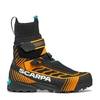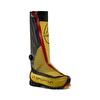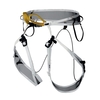Solleder-Lettenbauer on Civetta celebrates 100th anniversary
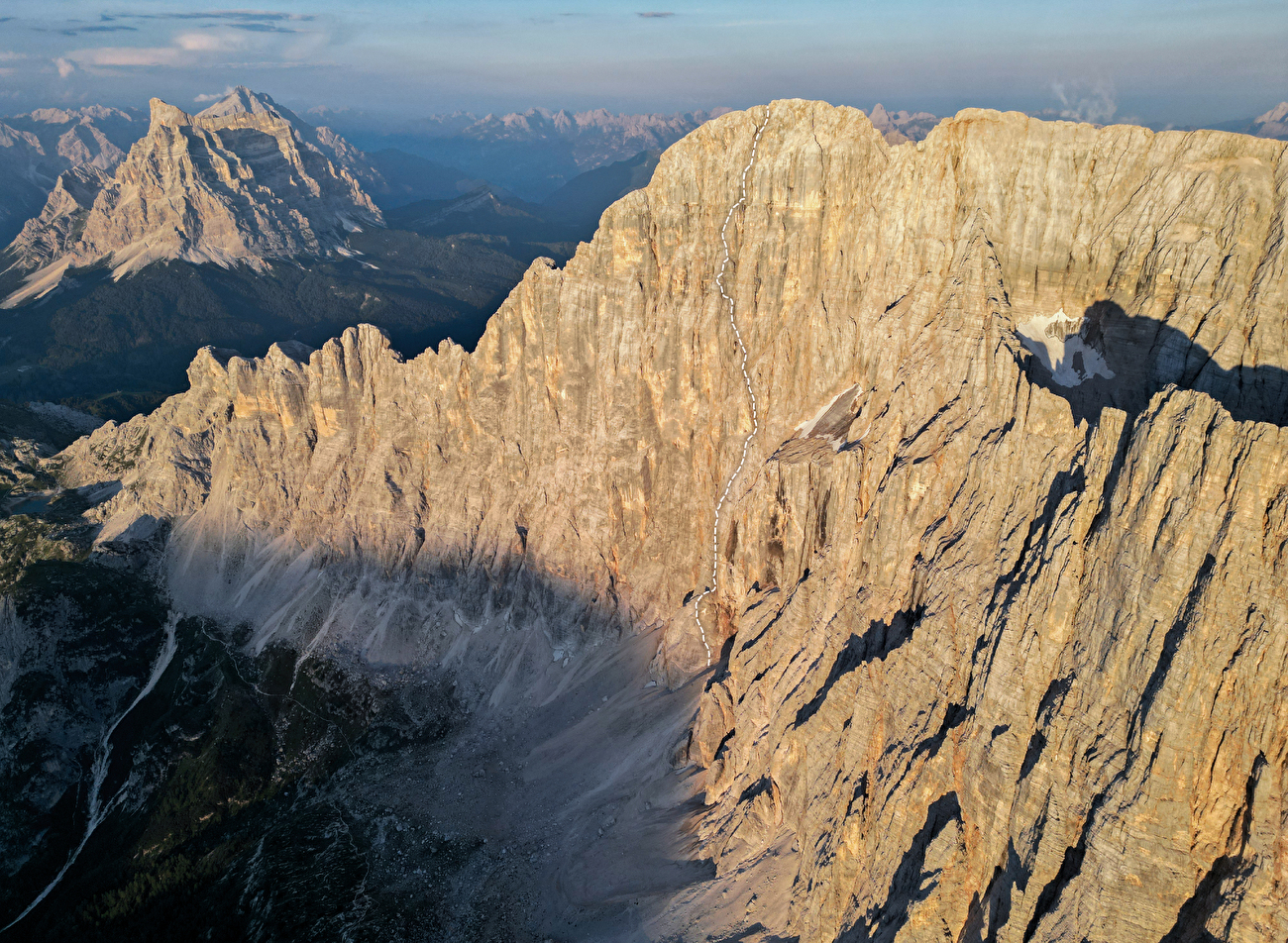
 1 / 9
1 / 9 Alessandro Baù / Luca Vallata
Alessandro Baù / Luca Vallata
The Solleder-Lettenbauer on Civetta’s Northwest Face, renowned for being the first sixth grade route in the Alps, turns 100 years old today. Over the past century, it has been a benchmark for the world's finest alpinists, who have tested themselves with solo ascents, winter climbs, and even solo winter attempts. A century later, this outstanding climb still stands as an extraordinary testament to the boldness of the two German alpinists.
This route remains a jewel worth repeating, especially when bearing in mind that its sheer 1,000 meters were, astonishingly, breached in a single day. Published below is the history of route, excerpted from the new guidebook "Civetta Northwest Face" by Alessandro Baù and Luca Vallata (Idea Montagna Editions).
A photo exhibition dedicated to the Solleder-Lettenbauer will open on Thursday, August 7th, in Alleghe (Piazza Kennedy, 6:00 PM), featuring stories and anecdotes about ascents on Civetta. Additionally, to celebrate the centennial, a major event is planned in Caprile on September 27th. Further details will be published in due course.
SOLLEDER-LETTENBAUER, CIVETTA, DOLOMITES (translated by Lynne Hempton)
“I knew that down there in the south there stood a steep rock castle, the Civetta; I had never seen it, but had often heard of it. [...] An immense wall, with terrible rock fall, and a lot of ice.”
The opening of the chapter devoted to the adventure on Civetta in Emil Solleder's book Die Civetta-Nordwand is one of the most famous lines in Dolomite literature. With its solemn register, it seems to give voice to an ancient knight preparing to lay siege to an impregnable fortress. Indeed, at that time an aura of expectation hovered over Val Civetta, as though awaiting a worthy suitor; the climbing problem represented by the central sector of the North-West had already entered the collective imagination and was a topic of discussion in mountaineering circles across the Alps. Nevertheless, there is no record of anyone ever having laid hands on it before 1925 (Solleder writes: “Preuss, Dibona, Innerkofler and a whole host of Englishmen with the best guides attempted it in vain”). Often, in the history of mountaineering, big problems have only been solved after a long series of attempts and retreats, but in this instance this was decidedly not the case. But let’s begin the story from the beginning.
The first part of the article from which the excerpt quoted in the inscription is taken (Die letzten großen Wandprobleme in den Dolomiten) is dedicated to the account of another feat, which preceded the climb on Civetta by a handful of days. On 1 August 1925, Solleder and Fritz Wiessner opened their route on the north face of Furchetta in the Odle group. This represented the first of the final three major unsolved problems of the Dolomites evoked in the title. The duo then moved immediately towards the second goal of their journey, the huge wall of the North-West face of Civetta. A momentary turn in the weather and some work commitments forced Wiessner to return to Dresden, so Solleder continued to Rifugio Coldai alone, with no firm plan in mind. There he met another two Germans who he didn't know: Franz Göbel and Gustav Lettenbauer. Solleder initially kept a low profile, hiding his real intentions, but when his new comrades revealed that they were intending to attempt a direct route on the North-West, he asked to join their team. So it was that the next day the three of them set out towards the face. They managed to climb roughly the first third of the wall, but had to stop and retreat after Göbel suffered an injury and it began to rain. During this first attempt, Lettenbauer solved the famous crack pitch, a laborious and strenuous crack that ascends obliquely to the left and marks the start of the harder climbing.
In many reports, Lettenbauer is often overshadowed by Solleder, but in fact the pair mainly shared the lead. Perhaps to compensate for this historical injustice, for several years now the friable crack is more commonly referred to as the Lettenbauer Crack. Three days after the first attempt, Solleder and Lettenbauer returned to try again and in one long and intense day successfully completed their route. The report of their ascent concludes with some simple and poetic sentences: “suddenly a crow swooped into sight just above us and a colder wind announced the end of the wall. We climbed a final overhanging section and stood on the final ridge under the starry sky.”
News of the feat resonated deeply in the mountaineering community, and the fact that Willo Welzenbach's climbing grade scale was being circulated at almost exactly the same time inextricably linked the Solleder-Lettenbauer to the mythical grade VI. The climbers, Solleder and Lettenbauer, both came from Munich, were almost the same age (born 1899 and 1900 respectively) and were both from working-class backgrounds. After the Great War, their city lived through the meteoric rise of the Bavarian Soviet Republic and the social context within which they grew up was characterised by precariousness, uncertainty and unemployment. In response to this climate of instability, many young people threw themselves heart and soul into climbing, which offered a means of self-assertion and an escape route.
Emil Solleder was an adventurous and individualistic spirit. Not much is known about his life; some sources report that he visited Alaska in the 1920s as a prospector and that he only became interested in mountaineering on his return to Europe. In any case, he obtained his Alpine Guide and Ski Guide licence in 1925, and the following year, at the age of 27, he solved the third of the last great problems with the ascent of the west face of Sass Maor (with Franz Kummer) on the Pale di San Martino. He continued his itinerant lifestyle until his death in a mountaineering accident in the Meije group in 1931.
Gustav Lettenbauer made numerous first ascents in the Mieminger and Karwendel mountains during his career, but the death of a friend on the mountain brought this journey to an abrupt end. His mechanical skills came in handy at various stages of his life: he forged the pitons he used on Civetta by himself and, after his retirement, founded a company in Erlangen that manufactured surgical instruments.
There must be a thousand stories about the Solleder-Lettenbauer route: repeats, retreats, accidents and rescues, and alas there is not space to tell them all. We will therefore limit ourselves to a quick review of the traditional first ascents.
The first solo repeat by Cesare Maestri in 1952 was followed by the epic first winter ascent in 1963. This adventure brought together some of the best Dolomite climbers of the time: Ignazio Piussi, Giorgio Redaelli and Toni Hiebeler, and Roberto Sorgato. However, when Sorgato was bedbound by an unexpected health problem, the other three continued to Rifugio Tissi and began their assault on the face. In the days that followed Sorgato's fever broke and the stubborn Bellunese convinced and enlisted a team of climbers from San Vito di Cadore, Marcello Bonafede and Natalino Menegus, and set off in pursuit of his friends. They began four days after the forerunners but by making use of their route-finding and cleaning work, they managed to catch them up, reaching the summit on the same day. Again, the anecdotes that accompany such a climb (stoking the camp fire with wooden chocks after the stove broke, for example) are too many to list. Instead, we will quote only the words that Roberto Sorgato dedicated to his friend Piussi, his companion on many ascents, on how he led them up the Solleder: “it was when everyone else was exhausted that he really came out. In the worst moments, in danger, he would start not talking to anyone: he would get a cold, mean look in his eyes. He would hammer in the pitons, pounding them, and climb with an impressive determination.”
The last decade of the third millennium opened with the impressive one-day ascent of the Philipp and Solleder routes by Manrico Dell'Agnola and Alcide Prati, and closed with the epic first solo winter ascent, carried out in five days in January 2000 by Marco Anghileri.
For several generations, the Solleder-Lettenbauer was a legendary rite of passage towards mountaineering maturity, an obligatory step in the career of every Dolomite climber. Today, however, it is often shunned because of the supposed danger and friability of the rock, and snubbed because of the relatively low technical difficulty. Yet despite its mixed fortunes, a hundred years after its opening it remains a monument to climbing and adventure, a magnificent journey through an immense wall.
Georges Livanos wrote these definitive words on the subject: “The imposing Civetta towered over us with all its regal might. It was indeed Solleder's “immortal wall”; the immortal line of his legendary route was always there, carved into the face.”
- Alessandro Baù and Luca Vallata



 Copia link
Copia link



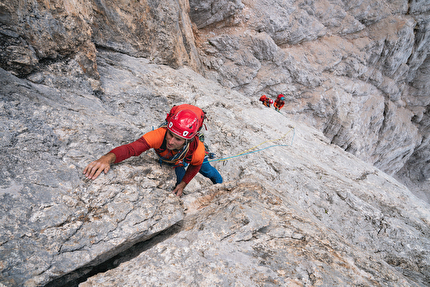
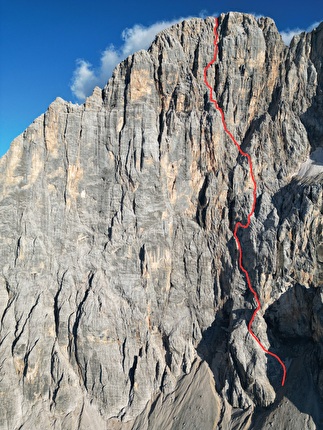
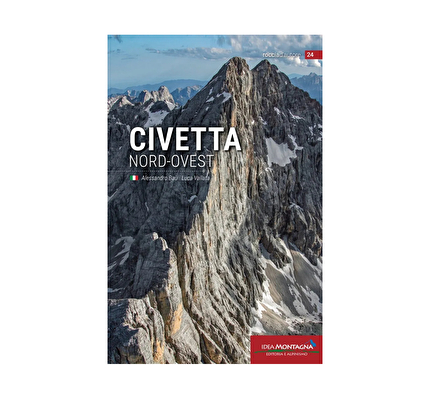
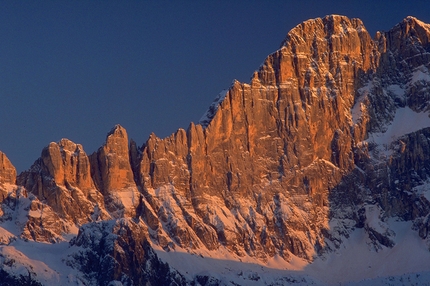
 See all photos
See all photos
















